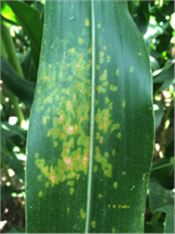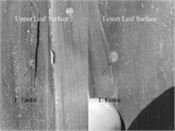Scouting Tips For Southern Rust In Corn
DR. TRAVIS FASKE
LONOKE, ARK.
Southern rust has NOT been found in Arkansas, but given the recent storm activity and warmer weather it is only a matter of time before someone finds it somewhere in the state or at least the mid-South. Reports of southern rust activity will be posted here or on the IPM-PIPE website. As of this report, the most common diseases on corn have been northern corn leaf blight and common rust. Both of these two diseases often subside as temperatures rise, while warm temperatures (often early July) fuel southern rust development. Because many are out scouting for southern rust, now is a good time to review a few scouting tips for southern rust.
Typically, scouting three to four days after a rain event (or events as been the case recently) when the sun is shining is a good strategy because southern rust pustules will be sporulating a maximum capacity, which makes them often easier to spot in the field. Though it is possible to find a single pustule on a leaf (often along the edge of the field), most frequently a cluster of pustules are detected in the mid to upper canopy when first detected in the field (Fig. 1).
Southern rust pustules are circular to oval in shape, small (0.2 to 2 mm long) orange in color often encircled by a light-green halo (Fig. 1). Southern rust sporulates on the upper leaf surface (Fig. 2), while common rust sporulates on both upper and lower leaf surfaces (to a lesser degree on lower surface). Common rust pustules are elongate (like small bricks), red in color, but when the sun is beaming brightly behind you those pustules can appear light orange. Bring them inside and let your eyes adjust before making a final inspection. Typically, common rust is found in the lower canopy (3 ft. and lower); however, this year it is common to find it in the mid canopy. Southern rust is almost always found above mid to upper canopy (4 to 5 ft. from ground). All of these factors are often needed to separate common from southern rust when scouting in June for corn diseases.
Conditions that favor disease consist of warm temperatures (80 to 90+ °F) and extended periods of light rain or heavy dew. When conditions favor disease, symptoms appear about 3 to 6 days after infection and by 7 to 10 days the pustules rupture to expose mature rust spores. In the absence of these conditions infection and pustule development will be much slower.
Fungicides are effective at suppressing southern rust; however, there is no economic threshold for a fungicide application. Factors to consider consist of corn stage of growth, hybrid susceptibility, yield potential, threat or observation of southern rust in the field, and prolonged conditions that favor disease development. It is generally accepted that a fungicide application between VT – R3 when southern rust is first detected in the field AND conditions favor disease is the most beneficial time to apply a fungicide to protect yield potential. After R3, beginning R4, it is unclear as to the exact benefit of the fungicide when rust is first detected, somewhat of a gray area, but considering some of the factors mentioned above when considering a fungicide. In university trials, fungicides applied at R5 (25 percent dent) had had little or no impact on protecting corn yield potential even when southern rust is easy to find in the upper canopy. Field corn within two weeks (50 percent starch line) from black layer will not benefit from a fungicide application to protect yield potential.
In most years, southern rust is first detected in July in Arkansas and most of the early planted corn will avoid the need for a fungicide. For those fields that require yield protection, there are several fungicides with good or excellent efficacy against southern rust. A list of fungicides and fungicide efficacy table can be found in the MP 154.
If you have questions about southern rust please contact Travis Faske at tfaske@uaex.edu. ∆
DR. TRAVIS FASKE: Extension Plant Pathologist, University of Arkansas

Figure 1. Southern rust pustules on upper corn leaf surface.

Figure 2. Southern rust pustule on upper and lower
corn leaf surfaces. Note the absence of
sporulation on the lower leaf surface.